new posts in all blogs
Viewing: Blog Posts Tagged with: Danny Fingeroth, Most Recent at Top [Help]
Results 1 - 4 of 4
How to use this Page
You are viewing the most recent posts tagged with the words: Danny Fingeroth in the JacketFlap blog reader. What is a tag? Think of a tag as a keyword or category label. Tags can both help you find posts on JacketFlap.com as well as provide an easy way for you to "remember" and classify posts for later recall. Try adding a tag yourself by clicking "Add a tag" below a post's header. Scroll down through the list of Recent Posts in the left column and click on a post title that sounds interesting. You can view all posts from a specific blog by clicking the Blog name in the right column, or you can click a 'More Posts from this Blog' link in any individual post.

By:
Heidi MacDonald,
on 3/25/2013
Blog:
PW -The Beat
(
Login to Add to MyJacketFlap)
JacketFlap tags:
Stephanie Buscema,
seth kushner,
Bernie Wrightson,
Bob Camp,
Asbury Park Comicon,
Steve Mannion,
News,
Interviews,
Robert Crumb,
Arthur C. Clarke,
Al Jaffee,
Top News,
Josh Bayer,
Jack Davis,
Jamal Igle,
Jay Lynch,
Michael Uslan,
Mark Mazz,
Mark Morales,
Unbearable,
Mad Magazine,
Will Eisner,
Asbury Lanes,
Rick Griffin,
Richard Corben,
Rat Bastard,
Rob Bruce,
Sarah Dyer,
Indie Comics,
Joe Kubert,
John Holmstrom,
Isaac Asimov,
Evan Dorkin,
Events,
Comics,
Conventions,
herb trimpe,
George Barris,
Heavy Metal Magazine,
Box Brown,
cliff galbraith,
Danny Fingeroth,
Chris Irving,
Dave Ryan,
Don McGregor,
Ed Roth,
Moebius,
National Lampoon,
Pierre Boulle,
R.O. Bleckman,
Mike Dawson,
Asbury Convention Hall,
Mike Zapcic,
Ming Chen,
Dean Haspiel,
Add a tag
If you’ve been following the history of the Asbury Park Comicon, which opened only a year ago in March of 2012, you know it’s been a strange, yet rather astonishing ride, but imagine how much stranger it must be for founder and indie comics creator Cliff Galbraith. What started in a bowling alley turned music venue and local hangout, Asbury Lanes, has become a major testament to demand for Comic Cons in New Jersey, and also a statement about the desires and tastes of con-goers who have relished the indie vibe of Galbraith’s brainchild. After a highly successful second Con in September of 2012, Galbraith announced that the Con would move to the much larger and even more historic venue of Asbury Park Convention Hall for its third event on March 30th 2013.
Then Superstorm Sandy struck, devastating the seaside town of Asbury Park, leaving the future of the Con in question. Against some difficult odds, the Con forged ahead, and Galbraith faced another kind of storm- media frenzy- over the upcoming Con. It’s fair to say that his phone has been ringing off the hook as local press as well as The New York Times have been trying to get the scoop on what looks to be a growing New Jersey institution as Asbury Park Comicon nears its biggest event yet. Dozens of prominent guests will be flanking this full-blown gala of a Con, and the Con will also be featuring panels and contests. Galbraith hasn’t had a moment’s rest since all this started more than a year ago, and he finished up several other interviews just in time to answer some questions about all this Con madness, and how it fits into his own life, for The Beat.
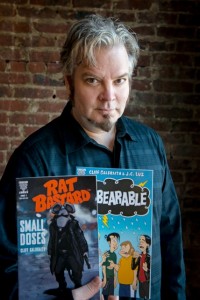
Hannah Means-Shannon: Can you remember the moment when the idea for starting a Comic Con in New Jersey first occurred to you? How wild did the idea seem at the time?
Cliff Galbraith: Maybe I’ve always wanted to run my own con. I’ve been to enough of them over the last few decades. A lot of them were pretty shabby. Customer service was pretty awful. I’ve been to cons where the promoter never came around and so much as said hello or how’s it going. Some were downright rude or deceitful.
On a Sunday in the summer of 2011, I stopped into the bowling alley/rock club Asbury Lanes — they were having a little record fair in there. I knew a few of my friends would be there selling and buying records or drinking beers so I figured I’d get away from my drawing table for the afternoon and see what was happening. My friend and neighbor Robert Bruce was selling an assortment of rare rock and jazz records and some underground comix. I remember looking at someone rooting through a white box of records, and I turned to Rob and I said “Where else have I seen somebody doing that? Reminds me of people at a comic convention digging through long boxes.” We laughed, but I walked around a bit and I kept thinking about it. If they could sell records in this place, why not comics? My friend Jenn Hampton was the manager, so I asked her if we could have a comic con at the Lanes. Nine months later we had the first Asbury Park Comicon.

HM-S: What’s the strangest task you’ve ever had to do in order to get a Con running or keeping it on track?
CG: Partner with Rob Bruce! We’re friends, but business-wise we’re been very independent, lone wolves. But it’s been a great experience and there’s absolutely no way I could’ve done all of this or come up with all the solutions on my own. It’s been Cliff and Rob’s Excellent Adventure.
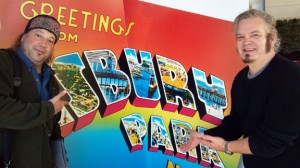
[Rob Bruce and Cliff Galbraith]
HM-S: Why Asbury as a location for the Con?
CG: People launch cons in New Jersey all the time. Some have been going on for years, but they don’t grow. I think the secret ingredient in throwing a Con is location — pick a fun destination. That’s really what set San Diego up for success early on. Who didn’t want to go somewhere with beautiful weather with plenty of bars, restaurants, hotels, a beach? That’s enticing.
So there needs to be something other than the Con once you walk outside. That’s my standard. I don’t want to go to some Con near an airport or far away from everything. I don’t want to go to some little hotel hermetically sealed in away from the world. Lots of Cons are downright depressing. They have no personality. Just putting a bunch of artists and dealers in a room and charging admission doesn’t make it fun.

[The Asbury Park Boardwalk at dusk]
HM-S: What were reactions like to the first Con at Asbury Lanes?
CG: Everyone had a great time. Most people sold lots of books. I was stunned. I just wanted to put on a little event and not screw up, just have a fun day. But the venue was a real hit. The exhibitors who’d never been to Asbury Park, who’d never been to Asbury Lanes fell in love with it. I’m spoiled, the Lanes are part of my world, but it’s really a cool old place. And there’s a bar. We played old punk tunes and Serge Gainsbourg, Nelson Riddle, soul, and stoner rock. It was more like a party — with comics.
HM-S: What obstacles did you face launching that first Con at the Lanes?
CG: It’s always tough at first to get someone with a name to attract fans. I think the first guy I called was Evan Dorkin. I always dug his work, and I’d known him for years — but more importantly he was someone who would get what I was trying to do. Evan and Sarah Dyer jumped right in. Then they told Steph Buscema. Jamal Igle was another old friend, so I contacted him early on. Those guys trusted me — that was important. But getting talent can be tough early on. Then there’s talent that doesn’t show up, there are flakes in this business and it just goes with the territory.
The biggest shock was that two months before our first Con, Asbury Lanes was sold. I know it sounds crazy, but I never got a written contract. I made a deal with my friend who was the manager. At one point, she didn’t know if she was going to still have a job or whether the new owners would honor our deal or want more money. It was scary, because this was our first time and if we screwed this up nobody would ever trust us again. It all worked out and it was a great day.

[APCC at the Asbury Lanes]
HM-S: What’s your personal philosophy behind Comic Cons?
CG: Don’t be boring. Don’t be predictable. Don’t call yourself a Comic Con and fill the bill with wrestlers, actors, and other people who have nothing to do with comics. Respect and honors those who make comics, especially those who came before us. I see a lot of bullshit at cons and I just don’t get it. If somebody wants an autograph of somebody from Twilight or some guy who played a storm trooper 30 years ago — that’s their business, but it really has nothing to do with comics. It detracts and devalues comics as something that is supposed to be celebrated. My feeling is if you’re not here for the comics then shove off. Go to a horror con, go to a sci-fi con.
HM-S: Why do you think we need Comic Cons, as a society?
CG: When my parents were kids the big thing was the circus coming to town. That’s disappeared, and now we have the Comic Con coming to town. Look at every city — there’s a con everywhere. People love it — its like Woodstock, Lollapalooza, county fair, chili cook-offs, boat shows, car shows, record fairs, film festivals, people want to get together with those who share their passion. They want to spend a day with their kids, meet new friends, make a discovery. It’s an amazing social phenomenon, and it’s in its infancy.
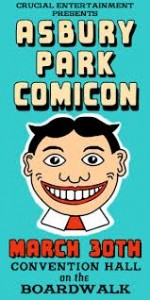
HM-S: What did you grow up reading? Any favorite comics or characters?
CG: My mom grew up in a candy store in Newark, N.J., and she spent her time drawing pictures of movie stars from magazines that were on the newsstand. She also loved comics. She introduced me to Superman when I was about four years old. She also taught me to draw. She got me a subscription to SUPERBOY and I looked forward to those comics every month. Then one day when I was getting a haircut, I picked up a copy of FANTASTIC FOUR that was in the barber shop — this was around 1965. The Kirby art kind of creeped me out at first, but I was fascinated. Joe Kubert’s HAWKMAN was a favorite. Of course BATMAN. CREEPY, EERIE, FAMOUS MONSTERS and hot rod magazines with stuff by Ed Roth and George Barris. I also read a lot of science fiction — it was a pretty classic age with Asimov, Arthur C. Clarke, and I read Pierre Boulle’s Planet of the Apes after seeing the movie. I graduated from super heroes to MAD. Then National Lampoon. At some point I found some underground comix in a head shop in Menlo Park, N.J. — they blew my teenage mind. Then Heavy Metal Magazine and Punk Magazine completed the process of completely warping my mind.
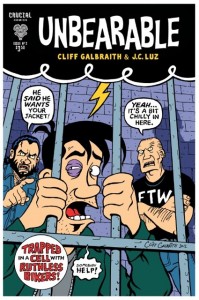
HM-S: What are your biggest influences as a comics creator?
CG: More of MAD than I used to acknowledge. I think it was an early influence in the way I saw a lot of stupid things in society. It was much tougher on politicians and corporations back in the 60′s and 70′s. I would try to draw like Mort Drucker when I was a kid. Kirby is an influence when I’m feeling lazy, when I think I’ve done enough — I think about the amount of work he put out in a day and I’m embarrassed. He keeps me going back to do a bit more before turning out the lights. I love Moebius. Bernie Wrightson, Richard Corben, Crumb, Rick Griffin, Jack Davis. I go back to Will Eisner when I get stuck on a drawing that’s not working — I’m still learning from looking at his drawings, I get answers from his panels. But when I created Partyasaurus, Beachasaurus, and all the Saurus characters back in the 80′s, I did some sort of R.O. Bleckman thing with the wiggly, broken lines. It was very successful, but I never revisited that style again.
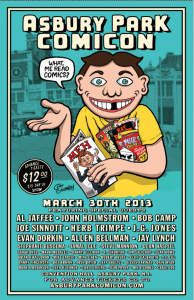
HM-S: It’s been a winding road for you career-wise. How does Con creating fit into your life, looking back?
CG: I came back to comics after ten years — at one point I was in really bad shape with Lyme disease, but that’s a whole other story. I started making RAT BASTARD comics again, just selling them at cons. I didn’t even go through Diamond — I just wanted to put something out and do some cons. Then I started working with my wife on UNBEARABLE, a totally different style but a lot of fun to draw. I was finally getting back into it, making comics. I had a few issues written I was drawing consistently and then this damn Asbury Park Comicon came along. The first one wasn’t too bad, but now with a much bigger venue, more guests, more exhibitors, ads, making a TV commercial, doing interviews with newspapers, and building a website, designing posters, it became a full time job. I didn’t realize it at first, but I sacrificed my art to build the Con. Which is okay, since April 1st I’m back at the drawing board and making comics again.
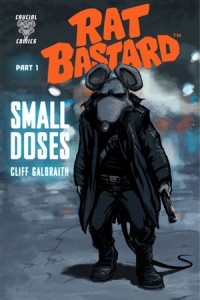
HM-S: Asbury Park was pretty hard hit by Superstorm Sandy. What was your own experience of the storm like?
CG: The other day I found pictures of my wife Judie and I at Convention Hall on the balcony making silly faces trying to stand up against the wind the day before the storm. I felt embarrassed that we were joking about it and twenty-four hours later there would be so much devastation. We could’ve have known, but I couldn’t look at those pictures. The fact that Convention Hall is still standing is amazing, but it did sustain a lot of damage.
My own experience with the storm was terror. There’s three giant pine trees in my yard that I was certain would crush us in the night. I felt like the roof on our house would be torn off any minute the whole time. We had no power for two weeks. We tried to stay in our home and tough it out with no power. I could draw during daylight. We had little parties with the neighbors and pooled our resources. After 7 or 8 days, it got too tough. It was cold. There wasn’t much to do once the sun went down. We had to go stay with my parents. But after a few days, I felt like I should be putting Led Zeppelin posters up in the basement — in other words, I felt like I was a teenager again. My parents were great about it, but you really can’t go back and live with your parents.
We were fortunate — we got to go back to our house and it was like nothing had happened other than we had to restock our refrigerator. But only two miles east of us looked like an A-bomb had been dropped. A lot of our friends suffered from that storm. We’ll be doing several things at Asbury Park Comicon to raise money for some of the nonprofits in our area and keep the focus on Sandy victims.
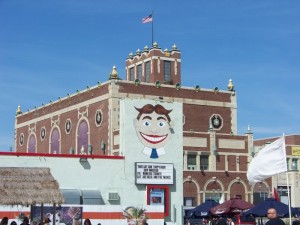
[The Asbury Convention Hall, site of APCC 2013]
HM-S: Were you afraid that damage from Superstorm Sandy might put the kaibosh on Asbury Park Comicon this year?
CG: It actually did. The building was going to be closed down by the city or something. We were told we needed to start thinking about an alternate site. It got pretty bleak. We looked into moving the con to Monmouth Racetrack, or one of the schools in Red Bank. We were desperate. And then I got a call late one night and they told me we were back in Convention Hall.
HM-S: What’s going on with Asbury Convention Hall? I hear it may not host events in the future after May.
CG: It’s an old building. It’s taken a beating. It had issues before the storm. So now it’s just better to shut down completely and get everything done once and for all. May 1st, it will be shuttered. We may be one of the last events there. This is a big thing for us to throw a con there — we grew up walking through the Grand Arcade from the boardwalk. I saw The Clash there, boxing, roller derby. To see our event on that marquee is like a dream come true — and it almost didn’t happen.

[Asbury Park Press covers COMIC BOOK MEN and Galbraith's upcoming Con]
HM-S: What’s up for Asbury Con in the future? Is it going to become an even bigger Jersey Con?
CG: We’ll know in a few weeks what the renovation schedule is for Convention Hall. We’d like to announce the dates for 2014 at this the con next week, but I don’t know if that’s quite possible by March 30th. But we’d like to move to late April and do a two day Con. The Berkley Hotel has a series of ballrooms — it’s like The Shining in there. I spoke to them last week. I’d like to keep this show in Asbury Park. Again, it’s the location that really makes a Con special. We’re planning on including more venues, galleries, etc. in the Con. Maybe a cosplay parade on the boardwalk. Put some of the bigger panels in the Paramount Theater.
We also have another big Con in the works for June 2014, but we haven’t finalized the date or exact venue. We’ve floated the ideas with a few comic industry people and we’ve gotten good feedback. The location will surprise a lot of people at first, but it makes sense geographically.

[Poster art for APCC#2 in 2012]
HM-S: What changes had to be made in the planning process of the con to move it from Asbury Lanes to the Convention Hall this time?
CG: Besides the amount of time Rob and I had to put into it, I’d say the next thing would be the amount of money it takes to launch an event this size. People have no idea what goes into a show like this. Now we’re into things like insurance, security, lighting, sound systems, putting guests in hotels, meals, travel, advertising — the expenses pile up quickly. This is no longer a fun little get-together at the Asbury Lanes with some comics and a few beers, this is a serious business venture.

[Memorable image from APCC #2 in 2012 with Evan Dorkin, Cliff Galbraith, Dean Haspiel, and Larry Hama]
The most important thing I’ve learned about running a show this size is we can’t do it on our own. We had a lot of help. Guys like Danny Fingeroth, Dean Haspiel, Seth Kushner, Chris Irving, Mark Mazz, Dave Ryan, all got us guests that we never would’ve gotten on our own. Eric Grissom built us a great website. Stu Wexler made a TV commercial — and nobody asked for anything in return. Mike [Zapcic] and Ming [Chen] from Comic Book Men have been promoting us for months on their podcast. The people who run Convention Hall have been amazing. They all just want us to succeed — we’ve got some great friends in our corner. We’ve also got some great guests: Al Jaffee, Herb Trimpe, John Holmstrom, Bob Camp, Don McGregor, Jamal Igle, Jay Lynch, Evan Dorkin, Sarah Dyer, Mark Morales, Stephanie Buscema, and Batman producer Michael Uslan. Then there’s a whole indie crew like Box Brown, Josh Bayer, Mike Dawson, Steve Mannion, and lots of others.
I’m really fortunate to be able to do this. To have gotten my health back, to be making comics again and to put on events with so many remarkable people. Sure it’s a lot of work, but I’m having the time of my life!

HM-S: Cliff, I don’t know how you found the time to give us such a detailed insight into your own personal journey envisoning the Asbury Park Comicon with only a few days to go until the biggest APCC yet. But we appreciate your willingness to talk about it so openly and thanks for bringing a Con of this caliber to New Jersey.
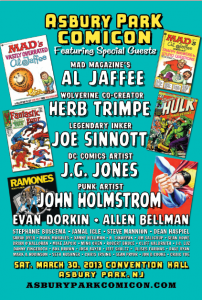
Hannah Means-Shannon writes and blogs about comics for TRIP CITY and Sequart.org and is currently working on books about Neil Gaiman and Alan Moore for Sequart. She is @hannahmenzies on Twitter and hannahmenziesblog on WordPress.

By:
Heidi MacDonald,
on 3/23/2013
Blog:
PW -The Beat
(
Login to Add to MyJacketFlap)
JacketFlap tags:
The Joker,
Carol Tilley,
Danny Fingeroth,
Denny O'Neil,
Seduction of the Innocent,
book-burning,
Dr. Frederic Wertham,
Heidi MacDonald,
James Reibman,
John Ordover,
Roy Thomas,
Sharon Packer,
Soho Gallery of Digital Art,
The Comics Code,
News,
Censorship,
Events,
History,
Comics,
Sociology,
DC,
Marvel,
Batman,
Joe Shuster,
David Hajdu,
psychiatrists,
Marvel Comics,
The Library of Congress,
DC Comics,
Craig Yoe,
Karen Green,
Top News,
Add a tag
As the first of several “Comic Book Roundtable” events to be held at the Soho Gallery of Digital Art under the auspices of gallery owner John Ordover and former Marvel editor, author, and educator Danny Fingeroth, this event exploring the life and legacy of Dr. Frederic Wertham was planned for the occasion of Wertham’s 118th birthday, but in the lead up to the event, recent developments in scholarship about the controversial comic reformer shed new light on the evening’s subject matter. In February 2013 Librarian, professor, and scholar Carol Tilley discovered, after examining Wertham’s papers held by the Library of Congress, that some of Wertham’s methods and reports were questionable, sparking debate in comics scholarship and among comics fans.

“Surely You’re Joking Dr. Wertham” hit the controversy head-on by bringing together a distinguished panel for discussion, including Tilley, comics writer, editor, and educator Denny O’Neil, author and educator David Hajdu, practising physician, psychiatrist, and author Sharon Packer, and author, editor, art director, and cartoonist Craig Yoe. The Soho Gallery provided excellent accompaniment to the event in the form of Wertham-related images and quotes displayed as a digital exhibit, and hosting a reception afterward.
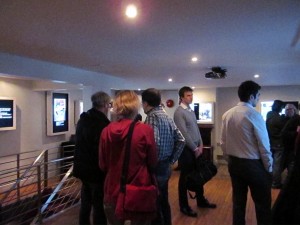
The evening opened to a thoroughly packed-in audience, among whom were many scholars and authors who have shown a public interest in Wertham’s career and legacy, including James Reibman, the official Frederick Wertham biographer designated by Wertham’s estate. Host and moderator Danny Fingeroth provided an introduction to Wertham in the form of slides including pictures of Wertham in and out of official capacity as a clinical psychiatrist working with children, and also reminded the audience of the other books Wertham authored aside from his now legendary Seduction of the Innocent, a critique on the “influence of comic books on today’s youth”, published in 1954. This placed Wertham within the context of other cultural reactions of the time that questioned the sex and violence being depicted in comics as appropriate for young readers.
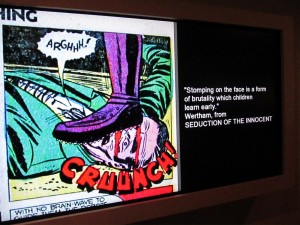
Tilley started off the panel discussion by explaining exactly what her recent research has uncovered about Wertham’s work. While her original intention was to locate materials relevant children’s education, she found “other things” that she didn’t expect to find among Wertham’s documents which she found “well-organized” in a “couple of dozen plus boxes” at the Library of Congress. The documents included copies of Wertham’s other research papers and speeches spanning his career, among which she found “discrepancies” and “some indication that he did things like combine the testimony of kids” or “broke apart” the testimony of one child “into four or five” in order to use quotes. This practice also resulted in evidence of “deleted or added” phrases from the children’s testimony that Wertham presented in Seduction of the Innocent and other works. This resulted, Tilley said, in a general “perception” of evidence in Wertham’s book that was “not the same as the actual case” of his research materials. When questioned about whether these changes were negligible or whether they altered the meaning of the children’s testimony, she confirmed that these “additions and word changes did change the meaning of testimony”. While Wertham’s book has often been criticized for its “lack of attribution” in footnotes or bibliography, Tilley feels that she has “seen personally” that his use of sources was not exacting enough. For those interested in Wertham’s legacy, this was something of a bombshell, though Tilley has been public about some of these findings previous to the evening’s discussion.
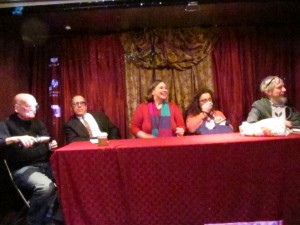
Hajdu then commented on Wertham as a figure, reminding the audience that Wertham is often a “handy symbol” of a wider movement against comic book excesses, and even a “personification” of the “cynicism toward comics in the late 40’s and 50’s”, even though he didn’t start this trend personally. Hajdu explained that even “newspaper comics incited criticism” prior to Wertham’s career and were often perceived as “crude, anti-literate” and examples of “defiant behavior” that raised public concern. The Catholic Church, particular, he noted, were active in inspiring state legislation against comics, due to their belief in the “power of aesthetics and the power of art” for both positive and negative influences on human behavior.
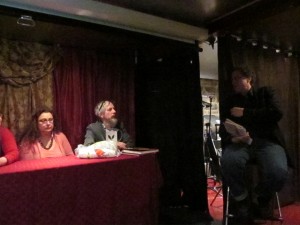
[Packer, Yoe, and Fingeroth]
O’Neil, himself raised Catholic, confirmed that his “first encounter with the (comic) witch hunters was in the pages of The Catholic Digest” and that he, as a young person “read and believed” that superhero comics, particularly, were potentially harmful. He related, to the audience’s amusement, that former Marvel editor Roy Thomas “as a kid” had participated in a book burning in Missouri where he “burned comics he was not interested in”, but rescued others he liked. Tilley briefly added that she had discovered evidence that librarians, too, had participated in comic burning and attempted to keep them out of libraries during this period because they were seen as “disruptive”.
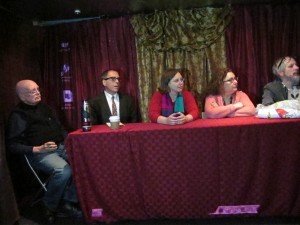
Packer suggested that Wertham’s book title, Seduction of the Innocent, might have spoken particularly to a Christian demographic because of its suggestion of the massacre of the innocents by King Herod related in the New Testament of the Bible. This led to a reassessment among the panellists of Wertham’s title, since its original version was “All Our Innocents”. Fingeroth pointed out that this change made the title “very pulp sounding” and therefore more sensational.
Yoe’s background on the subject of juvenile delinquency as an author, and also his discovery of the “fetish art” of Joe Shuster confirmed that there were real-life implications for the more violent aspects of comic art, such as the case of the Brooklyn Thrill Killers who killed indigent people and molested women and when interviewed by Wertham as an expert witness, confessed to being inspired in their deeds by Shuster’s artwork. Yoe, however, prompted a wide-ranging and at times heated discussion on the subject of exactly how and when Wertham’s papers at the Library of Congress had been made available for research purposes. Both Yoe and Hajdu, upon requesting access in the past, had been denied use of the papers since they were “sealed” until the children who participated in the studies had passed away. “In many ways, I respect Dr. Wertham”, Yoe said, but “the Library of Congress is our library” and its contents “should be seen” regardless of the circumstances behind their compilation. Outspoken attendee and Wertham biographer Reibman, who was granted access to the papers at a much earlier date in order to work on his book, disagreed with Yoe’s statement in favor of “freedom of information”, arguing that sealing Wertham’s papers at the library was part of the “terms of the gift” to the library. Reibman’s frequent interjections on behalf of Wertham during the event contributed to a rather heated atmosphere.
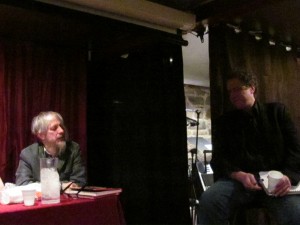
Yoe questioned further why some individuals, and not others, were then granted access despite the terms of the gift. Hajdu chimed in that he had requested access “dozens of times” but had been denied despite his academic credentials. Yoe asked Tilley if, based on her experience as a librarian, this discrepancy was “unusual” or not. Tilley confirmed that in her experience, the sealing of the papers while at the Library of Congress and then granting access to only those individuals sanctioned by the estate of the deceased, was indeed “unusual”. Attendee Karen Green, Graphic Novels Librarian at Columbia University, also commented that while “archives can be restricted”, for public documents this practice is “not usual”. Tilley provided further information about the situation by explaining that she was obliged to sign an agreement with the Library of Congress about the materials she accessed, even though a large portion of the Wertham papers consisted of “newspaper clippings” which “shouldn’t be restricted” anyway. Yoe brought some levity to the rapid fire questioning and often terse dialogue between he and Reibman by pointing out that Hajdu closely resembled a young Frederic Wertham and ought to have just turned up at the library, saying “I am here to see my papers”. Though Hajdu found the comparison amusing, he said “That’s the most offensive thing I’ve ever heard”.
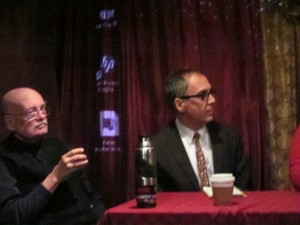
[O'Neil and Hajdu]
Fingeroth then gathered the reigns of the discussion as moderator to direct attention back to the panelists and away from the discursive arguments breaking out among audience members. Fingeroth asked O’Neil, specifically, if he had felt any “lingering hesitation” about comics after his experience with The Catholic Revue in childhood. O’Neil related that Wertham’s legacy, but particularly the Comics Code had impacted his career in comics. He was involved in “several public arguments” with administrators at comics publishing companies, wherein comics supporters felt the need to argue “comics are good, not evil anymore”. O’Neil’s personal feeling has always been, and still is, he said, that “If it’s censorship, it’s bad”, and often felt frustrated by the “vagueness of the language” in the Code itself, often leading comics creators to create elaborate avenues to get around the letter of the Code. He related a particularly frustrating incident where an IRONMAN story involving a “six story tall monster” crushing a police car was censored because it “showed disrespect to the police car” even though it also showed policemen being very brave in their fight against the monster. This kind of “idiocy” in the Code he particularly objected to, and added his motto that “blind worship of authority figures whether or not authority figures had any authority” should never be supported.
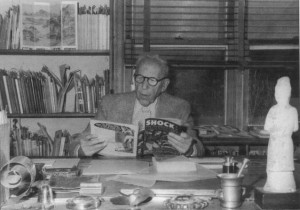
At this point, it was relevant to clarify that Wertham was not the founder of the Comics Code, though his work certainly paved the way for its development. Yoe reminded the audience that Wertham was, in fact, a progressive who was in support of the freedom of the press. It was more that Wertham “created the climate”, O’Neil supplied, which led to the Senate hearings, which led to the drafting of the Code. Both Yoe and O’Neil agreed that comics publishing was, in fact, in a very low economic position at the time of the Senate hearings anyway, due to the rise of paperback novel sales and TV watching. Yoe and O’Neil continued to discuss whether a “rating system” couldn’t have been created, rather than the unilateral Comics Code, in order to steer children away from more disturbing comics. Hajdu pointed out that the rating system was not in effect in Hollywood, by comparison, until the 1960’s, so there was not a particularly clear model to instate for comics at the time.

Fingeroth asked the panelists, and in particular, Packer, whether Wertham’s research was purely “anecdotal” or whether he furnished “hard statistics” when working with children. Packer provided some context as a clinical psychiatrists about the methods of the time during Wertham’s career. She compared Wertham to Sigmund Freud and pointed out that though “Freud was celebrated at that time”, “much of his original psychological literature” was “just as baseless” as Wertham’s methods. Tilley added that her survey of Wertham’s papers revealed that his “data was rich”, but it was just “how he used it rhetorically” that was “questionable”. Yoe commented that even though his rhetorical use of his data might lead us to view Wertham with increased suspicion, in the big picture, Wertham made a “pretty good case. Many comic books were not good for young children” in term of their content.
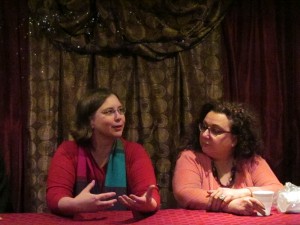
[Tilley and Packer]
Fingeroth took the question to a finer point. Did Wertham, he asked, in the opinion of the panelists, “take too many liberties” or not? Tilley stood her ground by asserting that “scientific investigation” requires accuracy, and a failure of accuracy is troubling from a scientist. Tilley added that her “personal sense” from working with the papers is that Wertham “cared more about getting rid of the comic book industry” than about his public cause of helping children develop in a psychologically healthy atmosphere. Though he certainly “cared for kids”, she reminded, she still felt that Wertham used children as “leverage” to achieve this greater goal of attacking the comics industry. One of the things that gave her a less than sterling impression of Wertham’s personality was discovering detailed transcripts that he “noted meticulously” of phone conversations that contained potentially harmful gossip about people who he saw as enemies in his career. He “collected information”, she said, “looking for weak spots” in the lives of people he wanted to undermine, particularly people who acted as “consultants for the comic book industry”.
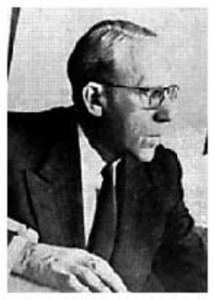
Fingeroth asked about Wertham’s movement, in his later career, toward criticism of the film industry and whether Wertham might have seen “comics as a stepping stone to a higher agenda” as a “career path”, but the general consensus among panelists seemed to be that comics were more easily attacked as a less profitable industry early in Wertham’s career, and that the tide of criticism had generally turned toward film around the time of Wertham’s developing interest in film. Film itself had, by the mid to late 60’s, become more overtly violent with works like Bonnie and Clyde.
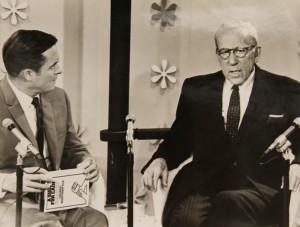
The rather charged atmosphere during the panel discussion gave way to an extensive question and answer period involving the audience and spanned a number of subjects. Did the distaste the comic book industry came to feel for Dr. Wertham result in a generally negative portrayal of psychiatry within comics? Yoe agreed that there are certainly plenty of “sinister psychiatrists” portrayed in comics tradition, and Packer supplied examples from Batman mythology including the Arkham family. O’Neil added that the character Harley Quinn was originally assigned to “cure” the Joker of his madness and instead was “driven nuts” herself. A more pointed question was posed about whether the possibility that Wertham skewed his evidence really made the questions he was asking about the role of comics at the time irrelevant. Hajdu fielded this question by commenting that the “weakest criticism of Wertham is that comics can’t affect minds and hearts”. As an art form, Hajdu argued, comics certainly do have impact and can “transform people”. “Comics have that power”, he reminded.
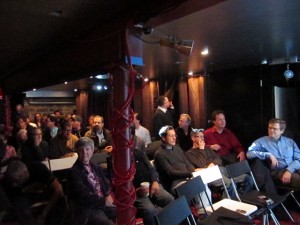
O’Neil weighed the issue by confessing that as a comics creator “You launch a given work and you have no way of knowing how it’ll bounce” and he often worried during his early career what impact particular comic stories might have on “kids already imbalanced”. O’Neil gave and example of his decision-making when he declined to include a “martial arts move” in one of his comics because it was “simple and damaging” and judged that kids might too easily learn to implement it. The audience, of course, immediately wanted O’Neil to demonstrate the deadly move, but he refrained in the interest of safety. For the same reason, O’Neil never allowed Molotov cocktails in his works, sure that it was too much of a “temptation” for kids to “see if it would work” building their own.

The Beat’s own Heidi MacDonald asked a rather burning question from the floor, one that continues to puzzle readers and comics historians alike: “Why do you think he attacked comics specifically? What did he hope to get out of it?”. The panelists answered in various ways. Yoe felt pretty strongly that Wertham was, in fact, motivated primarily by the fact that he “cared about kids” and was worried about the impact of comics. Packer analyzed Wertham a little by pointing out that Wertham himself, despite being married for many years, had no children of his own and this might have created a kind of “displacement” of concern for children that drove him to extremes. Hajdu simply stated that he felt Wertham to be “attracted to sensationalist cases” whether as an expert witness in extreme criminal cases or his research. He was, Hajdu said, a “publicity hound” at heart. Even Yoe added the admission that without a doubt Wertham had a “raging ego” driving his career.

Questions continued to circle back to the central role of Tilley’s new research on Wertham’s inconsistencies. How do we reassess Wertham based on the incorrectly conveyed details of his research, which clearly skewed his information in order to more sensationally and fundamentally support his thesis, when the “big picture” of his message, that extreme violence and sex in comics can be inappropriate for child readers, does seem sensible? Fingeroth presented a list of Wertham’s more “progressive” tendencies, stating that it’s possible to “go through a checklist of Wertham’s beliefs and agree except for comics” and respect many of his social contributions.
The final assessment of the panelists revealed some consensus out of a wide-ranging interrogation of Wertham’s method and legacy. O’Neil reminded the audience that Wertham was certainly not the “black-hearted villain” that many comics fans feel him to be, but he did detrimentally present those working in comics, “demonizing” them and making them out to be the “seducers and corruptors” of society, a crusade that damaged comics for decades to come. Yoe felt that the fundamental problem with Wertham’s whole approach to his subject was not necessarily the assumption that comics could be damaging to young minds, but that he “didn’t see that comics could be an art form”, and never commented on their positive potential as an “educational” resource. Yoe left the audience with the question, a lingering one, “Why couldn’t he see that?”. If Wertham had seen the potential of comics as a positive force, no doubt our current view of his work would also be more balanced on the whole.
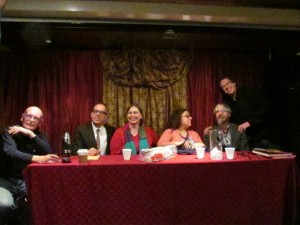
[The panelists and their moderator]
A predictably lively, but amicable, discussion period followed during the reception for the event, but if attendees expected definitive answers about the implications of Tilley’s new research on Wertham, they were left to their own devices. The panel discussion did provide solid context for Wertham’s life, work, and even a little for his motivations, as well as some solid information on what exactly Wertham’s failings as a researcher might be. Whether audience members were “pro-Wertham” or “anti-Wertham” initially, the discussion opened up new facets of his personality and work for further thought. Frederick Wertham may be less of a mystery now in the light of new research, but if anything, he’s even more of an enigma, confirmed as a complex figure. Learning more about Wertham changes perception of comics history, and that’s bound to change even more as scholars pay closer and closer attention to the records left behind in collections, personal archives, and thankfully, libraries.
The Comic Round Table events will continue this Spring at the SOHO Gallery for Digital Art with another hot topic in comics right now, the openly anti-gay position of Orson Scott Card and his work on SUPERMAN entitled “The Man of Steel vs. Orson Scott Card” on April 10th.
Hannah Means-Shannon writes and blogs about comics for TRIP CITY and Sequart.org and is currently working on books about Neil Gaiman and Alan Moore for Sequart. She is @hannahmenzies on Twitter and hannahmenziesblog on WordPress.

By:
Heidi MacDonald,
on 3/13/2013
Blog:
PW -The Beat
(
Login to Add to MyJacketFlap)
JacketFlap tags:
Philip Roth,
Will Eisner,
Saul Bellow,
Literary Comics,
Top News,
Danny Fingeroth,
Abraham Cahan,
Andrea Tsurumi,
Anzia Yezierska,
Contract with God,
Henry Roth,
Jeremy Dauber,
New York Comics and Picture-Story Symposium,
Will Eisner Week,
News,
Events,
Comics,
Cartoonists,
Add a tag
Towards the end of his life, witnessing the rise of the graphic novel as a format, Will Eisner commented on the fact that his books formed a subsection of the graphic novels display at a large bookstore by clarifying that his desire was to see his books shelved in the literature section alongside works by Jewish-American novelists of his generation (as expressed in an interview with David Hajdu). It’s enough to make you chuckle that he wasn’t pleased enough with the impact his books had on pushing the graphic novel format forward in American comics, but at the New York Comic and Picture-Story Symposium on the 11th of March, an Eisner-Week event critiqued the comparison between Eisner and his generation of fellow writers to see if his work stood up to his own claim of similarity. Speakers Jeremy Dauber (Professor in Yiddish Studies at Columbia University) and Danny Fingeroth (educator, author, former Marvel Comics editor and Chair of the Organizing Committee for Will Eisner Week) investigated Eisner’s use of setting, dialogue, and themes, as well as common cultural references he shared with his generation, to place Eisner in context and challenge the divide typically assumed between prose and comics media.
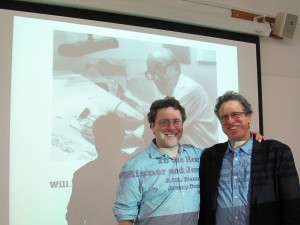
[Dauber and Fingeroth]
Dauber pointed out, in opening, that Will Eisner’s work is not usually considered in comparison to novels. He’s known for his prose, and often narrative-heavy work, but close textual comparisons between his writing style and those of his contemporary prose-writers is sparse, or even non-existent. Born in 1917, and “coming of age” in the 20’s and 30’s, Eisner, Dauber said, “was present a the foundational moment of Modern American Jewish Literature” and surrounded by the same influences and trends of major novelists of the period. Abraham Cahan, for instance, who fled from Czarist Russia to become a longtime editor of Yiddish newspapers in New York, was a “break through writer” in establishing Jewish-American literature. He often described the “urban landscape” as “something that’s alive”, as artist Andrea Tsurumi observed during audience participation. In comparison, Eisner’s CONTRACT WITH GOD gives a strong sense of place, and often speaks in a “high register” of prose, like Cahan’s work.
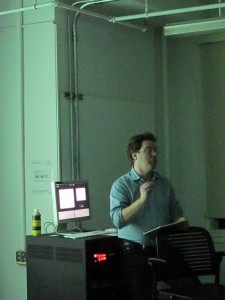
[Jeremy Dauber]
Another prose writer who became a “household name” during Eisner’s childhood was Anzia Yezierska, the “Cinderella of the tenements”, who often found herself in conflict with her parent’s generation, forged her high school diploma in order to attend college, and found herself exploring the conflict between the old and new world in her prose. Her use of dialogue, contrasting idiomatic Yiddish-English with her own more formal style of English speaks to a tension also visible in Eisner’s dialogue. Dauber presented novelist Henry Roth’s work as a final comparison in the use of dialogue to show differences in cultural background also found in Eisner’s Dropsie Avenue inhabitants. Dauber also pointed out a similar fascination with religious experience as a “transforming” force between Roth and Eisner.
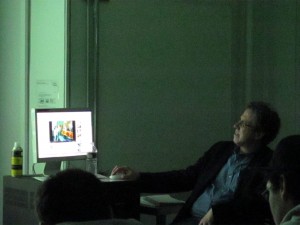
[Danny Fingeroth]
While Dauber explored prose comparisons between Eisner’s work and other Jewish-American novelists, Fingeroth took a more visual approach to putting Eisner in context. He addressed the fact that many of the novels of Eisner’s generation and milieu found their way into film adaptation, like Philip Roth’s GOODBYE COLUMBUS (1969). This forms a visual link to Eisner’s own graphic novels and work as an artist. Like Saul Bellow, Eisner also embraced a strong sense of comedy in his work, whereas authors like Bellow didn’t seem to acknowledge comics as an expression of their generation. In a video clip Fingeroth played for the audience, Eisner described himself as “growing up in an environment of prejudice and exploration of identity”, a theme certainly visible in many of the Jewish-American novels of the period. Eisner’s injected his characteristic humor by adding that writing was “inexpensive long term therapy” for these issues.
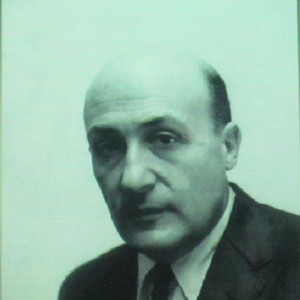
[Will Eisner]
Fingeroth described the “Jewish-American assimilation experience” as a common feature of Eisner’s work and his novelist contemporaries. CONTRACT WITH GOD, the “first thing” Eisner created in his long career that “wasn’t an actual assignment” allowed him the freedom to revisit these very personal experiences. Fingeroth also noted that a common cultural reference among these writers was Baseball, as seen in Philip Roth’s THE GREAT AMERICAN NOVEL, and in Eisner’s artwork on “The Adventures of Rube Rooky”. Writing about baseball, Fingeroth explained, was a “leveling process” between cultures that became part of the assimilation process. Visually speaking, Fingeroth said, Eisner was a “master of this craft of depicting urban life” found in celebrated Jewish-American novels. Particularly in A CONTRACT WITH GOD, Eisner, “given the freedom to do what he wanted to…came up with stories based on the Bronx of his youth”, like other writers of his generation.
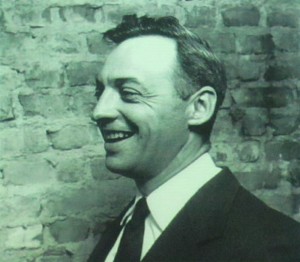
[Saul Bellow]
Fingeroth reminded the audience that exploring Eisner’s prose shouldn’t take away from Eisner’s own assertion that he “wrote with pictures”, though. According to Dauber and Fingeroth’s research, Eisner wrote “as well as anyone” else prominent in his generation. To understand Eisner’s legacy, we have to keep in mind that he “thought of himself as someone who wouldn’t be complete without pictures”, Fingeroth said. So, after this careful textual and cultural comparison between Eisner and the Jewish-American novelists of his day, what was the verdict? Could Eisner’s works be placed in the “literature” section of a bookstore next to the novels he felt expressed the same messages? “Will made it”, Fingeroth confirmed, “He belongs there, too”.

During the question and answer period, discussion turned toward Eisner’s overwhelming drive to raise awareness of comics as a medium. Fingeroth described Eisner as being on a “mission to explain his own life and to legitimize comics”. It’s a puzzling thing that Eisner apparently wanted graphic novels to be seen as “mainstream” literature rather than as a separate format, but the answer may lie in his sense that graphic novels were still being segregated from literature and therefore not treated as equal creative achievements. The double presentation of Eisner’s work in context from Dauber and Fingeroth made a strong argument for Eisner’s status alongside novelists of his day, especially in terms of subject matter and prose style. Dauber and Fingeroth presented reasonable evidence that Eisner’s work could be reshelved in the literature section at any bookstore, but it might cause quite a tug of war with those who see his work of “legitimizing” comics as most at home in a separate graphic novels section of books. “Ideally, all sorts of books could be shelved in more than one section of a bookstore or library,” Fingeroth added in a follow-up comment, “but a variety of practical reasons make that unlikely for the time being. Online venues seem to be able to do it, though, so hopefully some version of that will come to brick-and-mortar outlets, too.” So, why not place Eisner’s books in both locations? It might remind readers, for one thing, to view Eisner as a cultural peer of many of the novelists he revered.
Hannah Means-Shannon writes and blogs about comics for TRIP CITY and Sequart.org and is currently working on books about Neil Gaiman and Alan Moore for Sequart. She is @hannahmenzies on Twitter and hannahmenziesblog on WordPress.

By:
Heidi MacDonald,
on 1/28/2013
Blog:
PW -The Beat
(
Login to Add to MyJacketFlap)
JacketFlap tags:
News,
Comics,
DC,
Culture,
Superman,
Joe Shuster,
Jerry Siegel,
DC Comics,
Karen Green,
Paul Levitz,
Larry Tye,
Jim Shooter,
Top Comics,
Center for Jewish History,
Danny Fingeroth,
David Weiss,
Harry Donenfeld,
Jenette Kahn,
Mort Weisinger,
Nicky Wheeler-Nicholson Brown,
Samuel Norich,
Superman's 75th Anniversary,
Add a tag
TweetThe Center for Jewish History hosted a celebration of the 2013 75th birthday of the seminal superhero Superman on January 27th with co-sponsorship from Columbia University Library. Though Superman’s cover-date advent in comics occurred in June of 1938, celebrations are gearing up early to take a look back at the Kryptonian’s origins and the impact [...]









































[...] The Beat has a nice interview with indie comics creator Cliff Galbraith on founding and running the relatively new Asbury Park Comicon. I especially liked this quote: [...]